'Account of the Raid on Zeebrugge by ships of the Royal Navy', by Leading Stoker Norbert Joseph McCrory, c.1918 - Part 1
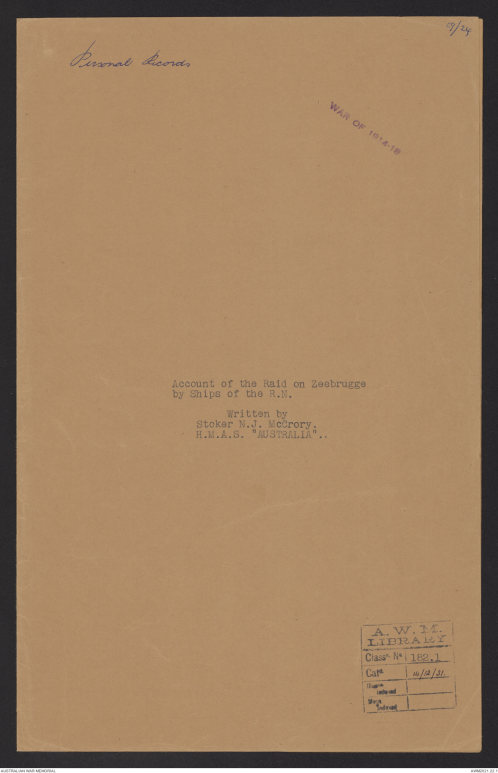
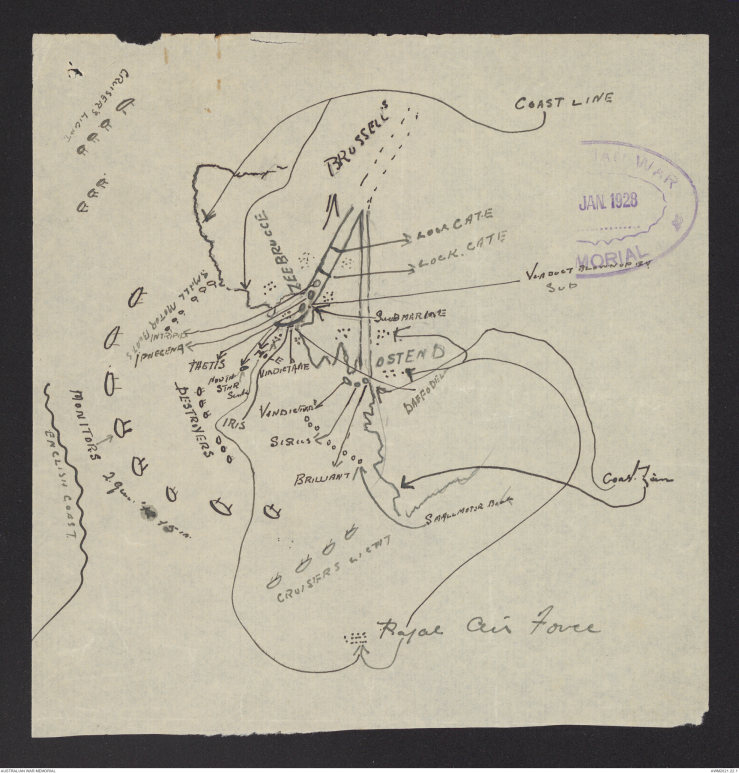
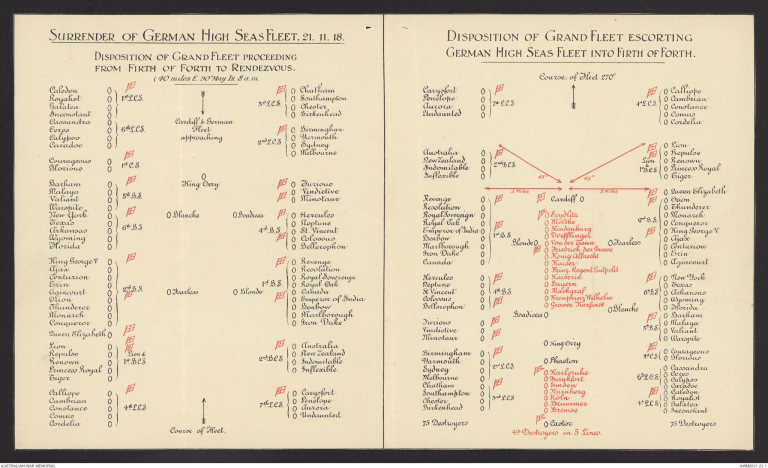
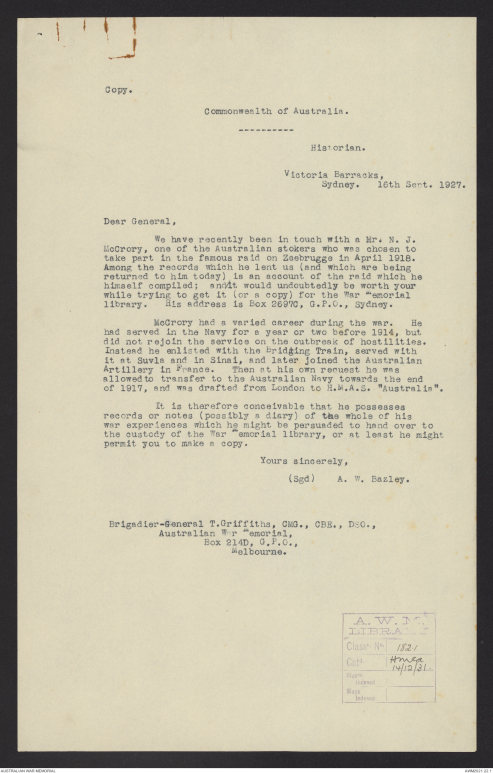
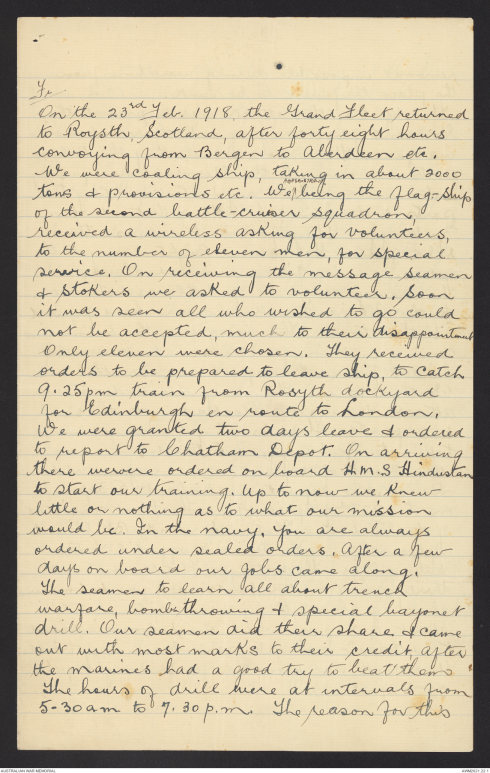
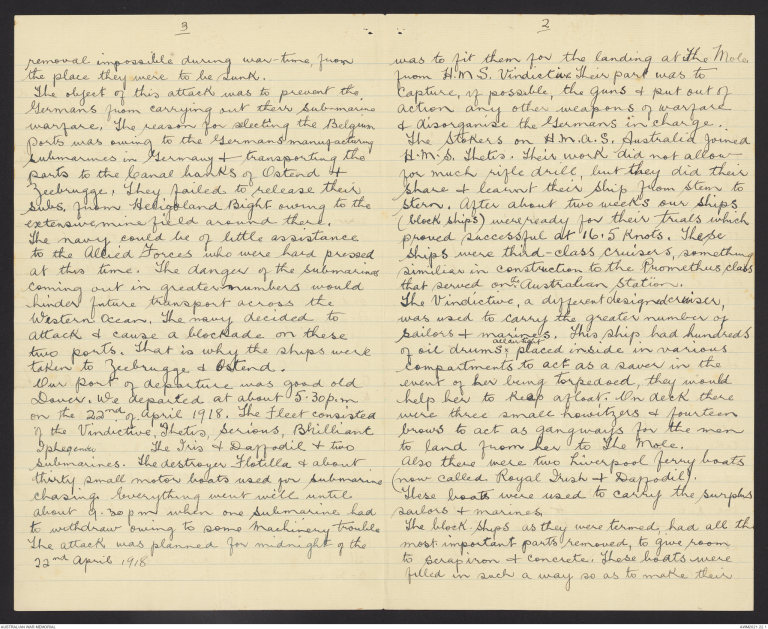
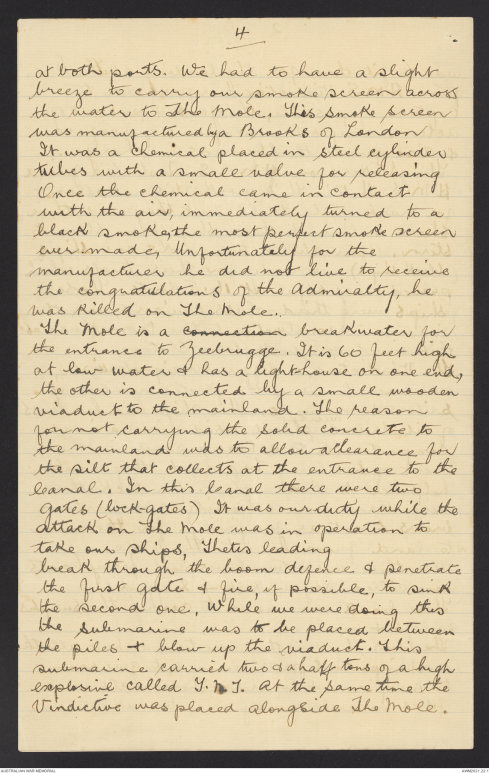
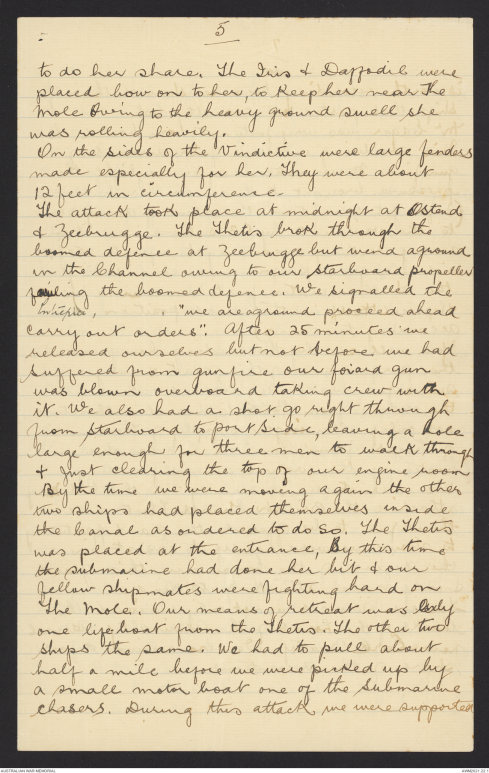
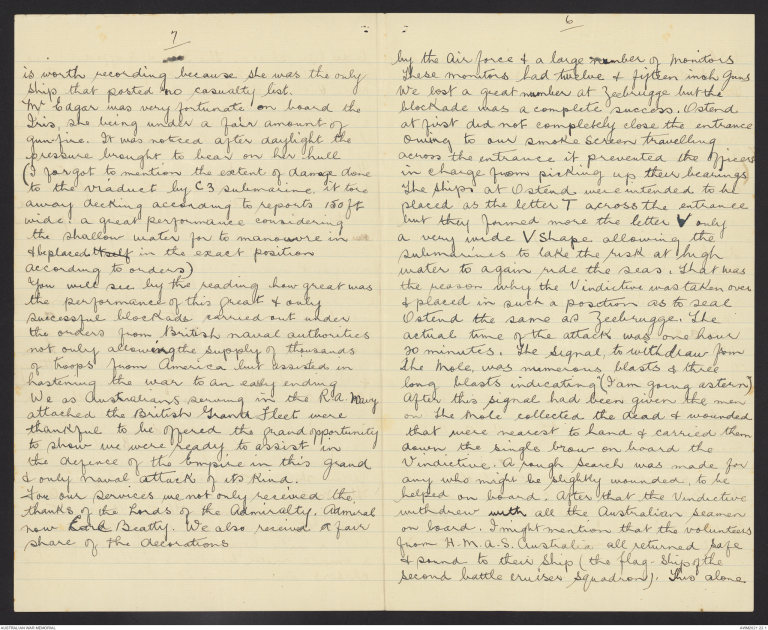
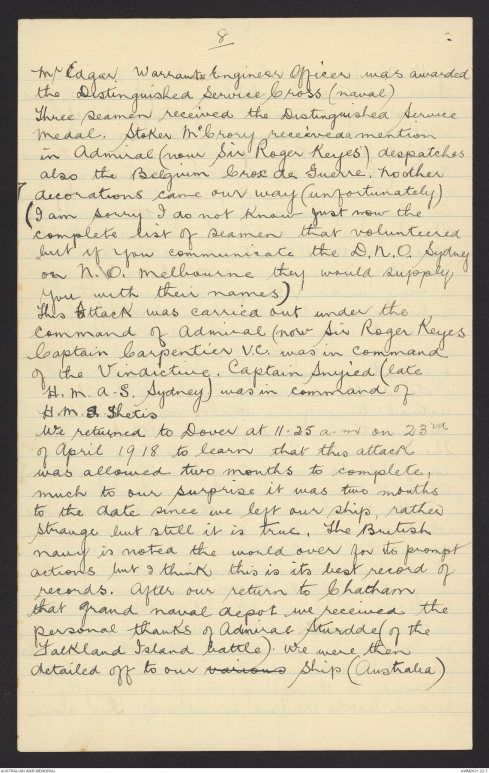
[*19/24
Personal Records
WAR OF 1914-18*]
Account of the Raid on Zeebrugge
by Ships of the R.N.
Written by
Stoker N.J. McCrory.
H.M.A.S. "AUSTRALIA".
A.W.M.
LIBRARY
Classn No. 182.1
Catg 14/12/31.
Diagram - see original document
SURRENDER OF GERMAN HIGH SEAS FLEET 21.11.18.
DISPOSITION OF GRAND FLEET PROCEEDING
FROM FIRTH OF FORTH TO RENDEZVOUS.
(40 miles E. 90° May Is. 8 a.m.
| Caledon 0) |
⇓ |
(0 Chatham | ||
| Royalist 0) | 1st L.C.S | (0 Southampton | ||
| Galatea 0) | 3rd L.C.S | (0 Chester | ||
| Inconstant 0) | (0 Birkenhead | |||
| Cassandra 0) | Cardiff & Seaman | (0 Birmingham | ||
| Ceres 0) | 6th L.C.S | Fleet | (0 Yarmouth | |
| Calypso 0) | approaching | 2nd L.C.S | (0 Sydney | |
| Caradoc 0) | (0 Melbourne | |||
| Courageous 0 | 1st C.S | |||
| Glorious 0 | ||||
|
0 |
||||
| Barham 0) | King Orry | 0 Furious | ||
| Malaya 0) | 0 Vindictive | |||
| Valiant 0) | 5th B.S. | 0 Minotaur | ||
| Warspite 0) | ||||
| New York 0) |
0 Blanche |
0 Boadicea |
(0 Hercules | |
| Texas 0) | (0 Neptune | |||
| Arkansas 0) | 6th B.S. | 4th B.S | (0 St. Vincent | |
| Wyoming 0) | (0 Colossus | |||
| Florida 0) | (0 Bellerophon | |||
|
King George V 0) |
(0 Revenge | |||
| Ajax 0) | (0 Resolution | |||
| Centurion 0) | (0 Royal Sovereign | |||
| Erin 0) | 1st B.S | (0 Royal Oak | ||
| Agincourt 0) | 2nd B.S. | 0 Fearless | 0 Blonde | (0 Canada |
| Orion 0) | (0 Emperor of India | |||
| Thunderer 0) | (0 Benbow | |||
| Monarch 0) | (0 Marlborough | |||
| Conqueror 0) | (0 Iron Duke | |||
| Queen Elizabeth 0) | ||||
| Lion 0) | (0 Australia | |||
| Repulse 0) | (0 New Zealand | |||
| Renown 0) | [[?]] | (0 Indomitable | ||
| Princess Royal 0) | 1st B.C.S. | 2nd B.C.S | (0 Inflexible | |
| Tiger 0) | ||||
| Calliope 0) | (0 Carysfort | |||
| Cambrian 0) | (0 Penelope | |||
| Constance 0) | 4th L.C.S | 7th L.C.S. | (0 Aurora | |
| Comus 0) | (0 Undaunted | |||
| Cordelia 0) |
⇑ |
|||
| Course of Fleet. |
DISPOSITION OF GRAND FLEET ESCORTING
GERMAN HIGH SEAS FLEET INTO FIRTH OF FORTH.
| Course of Fleet 270° | ||||
| Carysfort 0) | (0 Calliope | |||
| Penelope 0) | 4th L.C.S | (0 Cambrian | ||
| Aurora 0) | 7th L.C.S | (0Constance | ||
| Undaunted 0) | (0 Comus | |||
| (0 Cordelia | ||||
| Australia 0) | (0 Lion | |||
| New Zealand 0) | (0 Repulse | |||
| Indomitable 0) | 2nd B.C.S. | Lion & |
(0 Renown | |
| Inflexible 0) | 1st B.C.S | (0 Princess Royal | ||
| (0 Tiger | ||||
| (0 Queen Elizabeth | ||||
| Revenge 0) | Cardiff 0 | (0 Orion | ||
| Resolution 0) | 0 Sandlite | (0 Thunderer | ||
| Royal Soverign 0) | 0 Mislche | 2nd B.S. | (0 Monarch | |
| Royal Oak 0) | 0 Hindenburg | (0 Conqueror | ||
| Emperor of India 0) | 1st B.S. | 0 Derfflinger | (0 King George V | |
| Benbow 0) | Blonde 0 | 0 Von der Tann | 0 Fearless | (0 Ajax |
| Marlborough 0) | 0 Friedrich der [[?]] | (0 Centurion | ||
| Iron Duke 0) | 0 Konig Albrecht | (0 Erin | ||
| Canada 0) | 0 Kaiser | (0 Agincourt | ||
| 0 Prinz-Regent Luitpold | ||||
| Hercules 0) | 0 Kaiserin | (0 New York | ||
| Neptune 0) | 0 Bayern | (0 Texas | ||
| St Vincent 0) | 4th B.S | 0 Markgral | 6th B.S | (0 Arkansas |
| Colossus 0) | 0 Kronprinz Wilhelm | (0 Wyoming | ||
| Bellerophon 0) | 0 Grovner Burford | (0 Florida | ||
| Boadicea 0 | 0 Blanche | (0 Barham | ||
| Furious 0) | (0 Malaya | |||
| Vindictive 0) | 5th B.S | (0 Valiant | ||
| Minotaur 0) | (0 Warspite | |||
| King Orry | ||||
| Birmingham 0) | 4th C.S | (0 Courageous | ||
| Yarmouth 0) | Phaeton | (0 Glorious | ||
| Sydney 0) | 0 Karlsruhe | (0 Cassandra | ||
| Melbourne 0) | 0 Frankfort | 6th L.C.S | (0 Ceres | |
| Chatham 0) | 0 Emden | (0 Calypso | ||
|
Southampton 0) |
0 Kuenberg | (0Caledon | ||
| Chester 0) | 0 Koln | (0 Royalist | ||
| Birkenhead 0) | 0 Drummer | 4th L.C.S | (0 Galatea | |
| 0 Bremar | (0 Inconstant | |||
| 75 Destroyers | 0 Castor | 75 Destroyers | ||
| 49 Destroyers in 5 Lines |
[*I put the ships that are in red into Italic as we do not have the choice of red as a colour. I also could not draw the red arrows*]
Copy.
Commonwealth of Australia.
Historian.
Victoria Barracks,
Sydney. 16th Sept. 1927.
Dear General,
We have recently been in touch with a Mr. N. J.
McCrory, one of the Australian stokers who was chosen to
take part in the famous raid on Zeebrugge in April 1918.
Among the records which he lent us (and which are being
returned to him today) is an account of the raid which he
himself compiled; and it would undoubtedly be worth your
while trying to get it (or a copy) for the War Memorial
library. His address is Box 2697C, G.P.O., Sydney.
McCrory had a varied career during the war. He
had served in the Navy for a year or two before 1914, but
did not rejoin the service on the outbreak of hostilities.
Instead he enlisted with the Bridging Train, served with
it at Suvla and in Sinai, and later joined the Australian
Artillery in France. Then at his own request he was
allowed to transfer to the Australian Navy towards the end
of 1917, and was drafted from London to H.M.A.S. "Australia".
It is therefore conceivable that he possesses
records or notes (possibly a diary) of the whole of his
war experiences which he might be persuaded to hand over to
the custody of the War Memorial library, or at least he might
permit you to make a copy.
Yours sincerely,
(Sgd) A.W. Bazley.
Brigadier-General T. Griffiths, CMG., CBE., DSO.,
Australian War Memorial,
Box 214D, G.P.O.,
Melbourne.
A.W.M.
LIBRARY
Classn No. 182.1
Catg HMea
14/12/31.
Fr
On the 23rd Feb. 1918 the Grand Fleet returned
to Roysth, Scotland, after forty eight hours
convoying from Bergen to Aberdeen etc.
We were coaling ship, taking in about 2000
tons & provisions etc. We ^Australians being the flag-ship
of the second battle-cruiser squadron,
received a wireless asking for volunteers,
to the number of eleven men, for special
service. On receiving the message seamen
& stokers we asked to volunteer. Soon
it was seen all who wished to go could
not be accepted, much to their disappointment
Only eleven were chosen. They received
orders to be prepared to leave ship, to catch
9.25pm train from Rosyth dockyard
for Edinburgh en route to London.
We were granted two days leave & ordered
to report to Chatham Depot. On arriving
there wewere ordered on board H.M.S Hindustan
to start our training. Up to now we knew
little or nothing as to what our mission
would be. In the navy, you are always
ordered under sealed orders. After a few
days on board our jobs came along.
The seamen to learn all about trench
warfare, bomb throwing & special bayonet
drill. Our seamen did their share & came
out with most marks to their credit, after
the marines had a good try to beat them
The hours of drill were at intervals from
5-30 a.m. to 7.30 p.m. The reason for this
3
removal impossible during war-time, from
the place they were to be sunk.
The object of this attack was to prevent the
Germans from carrying out their submarine
warfare. The reason for selecting the Belgium
ports was owing to the Germans manufacturing
submarines in Germany & transporting the
parts to the Canal banks of Ostend +
Zeebrugge. They failed to release their
subs from Heligoland Bight owing to the
extensive mine field around there.
The navy could be of little assistance
to the Allied Forces who were hard pressed
at this time. The danger of the Submarines
coming out in greater numbers would
hinder future transport across the
Western Ocean. The navy decided to
attack & cause a blockade on these
two ports. That is why the ships were
taken to Zeebrugge & Ostend.
Our port of departure was good old
Dover. We departed at about 5.30p.m
on the 22nd of. April 1918. The Fleet consisted
of the Vindictive, Thetis Serious, Brilliant
Iphegenia The Iris & Daffodil & two
Submarines. The destroyer Flotilla & about
thirty small motor boats used for submarine
chasing. Everything went will until
about 9.30pm when one submarine had
to withdraw owing to some machinery trouble
The attack was planned for midnight of the
22nd April 1918
2
was to fit them for the landing at The Mole
from H.M.S. Vindictive Their part was to
capture, if possible, the guns & put out of
action any other weapons of warfare
& disorganise the Germans in charge.
The Stokers on H.M.A.S. Australia joined
H.M.S. Thetis. Their work did not allow
for much rifle drill, but they did their
share & learnt their ship from stem to
stern. After about two weeks our ships
(block ships) were ready for their trials which
proved successful at 16.5 knots. These
ships were third-class cruisers, something
similiar in construction to the Promethus class
that served on ^the Australian Station.
The Vindictive, a different designed cruiser,
was used to carry the greater number of
sailors & marines. This ship had hundreds
of oil drums, ^all airtight placed inside in various
compartments to act as a saver in the
event of her being torpedoed, they would
help her to keep afloat. On deck there
were three small howitzers & fourteen
brows to act as gangways for the men
to land from her to The Mole.
Also there were two Liverpool ferry boats
(now called Royal Irish & Daffodil).
These boats were used to carry the surplus
sailors & marines.
The block ships as they were termed, had all the
most important parts removed, to give room
to scrap iron & concrete. These boats were
filled in such a way so as to make their
4
at both ports. We had to have a slight
breeze to carry our smoke screen across
the water to The Mole. This smoke screen
was manufactured by a Brooks of London
It was a chemical placed in steel cylinder
tubes with a small valve for releasing
Once the chemical came in contact
with the air, immediately turned to a
black smoke, the most perfect smoke screen
ever made. Unfortunately for the
manufacturer he did not live to receive
the congratulations of the Admiralty, he
was killed on The Mole.
The Mole is a connection breakwater for
the entrance to Zeebrugge. It is 60 feet high
at low water & has a light-house on one end,
the other is connected by a small wooden
viaduct to the mainland. The reason
for not carrying the solid concrete to
the mainland was to allow a clearance for
the silt that collects at the entrance to the
canal. In this Canal there were two
gates (lock-gates) It was our duty while the
attack on The Mole was in operation to
take our ships, Thetis leading
break through the boom defence & penetrate
the first gate & fire, if possible, to sink
the second one. While we were doing this
the submarine was to be placed between
the piles & blow up the viaduct. This
submarine carried two & a half tons of a high
explosive called T.N.T. At the same time the
Vindictive was placed alongside The Mole.
5
to do her share. The Iris & Daffodil were
placed bow on to her, to keep her near The
Mole Owing to the heavy ground swell she
was rolling heavily.
On the sides of the Vindictive were large fenders
made especially for her. They were about
12 feet in circumference.
The attack took place at midnight at Ostend
& Zeebrugge. The Thetis brok through the
boomed defence at Zeebrugge but wend aground
in the Channel owing to our starboard propeller
fouling the boomed defence. We signalled the
Intrepid, "we are aground proceed ahead
carry out orders". After 25 minutes we
released ourselves but not before we had
suffered from gunfire our forward gun
was blown overboard taking crew with
it. We also had a shot go right through
from Starboard to Port Side, leaving a hole
large enough for three men to walk through
& just clearing the top of our engine room
By the time we were moving again the other
two ships had placed themselves inside
the Canal as ordered to do so. The Thetis
was placed at the entrance, By this time
the submarine had done her bit & our
fellow shipmates were fighting hard on
The Mole. Our means of retreat was only
one lifeboat from the Thetis. The other two
ships the same. We had to pull about
half a mile before we were picked up by
a small motor boat one of the Submarine
chasers. During this attack we were supported
7
is worth recording because she was the only
ship that posted no casualty list.
Mr Edgar was very fortunate on board the
Iris, she being under a fair amount of
gun fire. It was noticed after daylight the
pressure brought to bear on her hull
(I forgot to mention the extent of damage done
to the viaduct by C3 submarine, it tore
away decking according to reports 150 ft
wide. a great performance considering
the shallow water for to manouvre in
& be placed itself in the exact position
according to orders)
You will see by the reading how great was
the performance of this great & only
successful blockade carried out under
the orders from British naval authorities
not only allowing the supply of thousands
of troops from America but assisted in
hastening the war to an early ending
We as Australians serving in the R.A. Navy
attached the British Grand Fleet were
thankful to be offered the grand opportunity
to show we were ready to assist in
the defence of the Empire in this grand
& only naval attack of its kind.
For our services we not only received the
thanks of the Lords of the Admiralty, Admiral
now Earl Beatty. We also received a fair
share of the decorations
6
by the Air force & a large number of monitors
These monitors had twelve & fifteen inch guns
We lost a great number at Zeebrugge but the
blockade was a complete success. Ostend
at first did not completely close the entrance
owing to our smoke screen travelling
across the entrance it prevented the officers
in charge from picking up their bearings
The ships at Ostend were intended to be
placed as the letter T across the entrance
but they formed more the letter V only
a very wide V shape allowing the
submarines to take the risk at high
water to again ride the seas. That was
the reason why the Vindictive was taken over
& placed in such a position as to seal
Ostend the same as Zeebrugge. The
actual time of the attack was one hour
20 minutes. The signal to withdraw from
The Mole was numerous blasts & three
long blasts indicating (I am going astern)
After this signal had been given the men
on The Mole collected the dead & wounded
that were nearest to hand & carried them
down the single brow on board the
Vindictive. A rough search was made for
any who might be slightly wounded, to be
helped on board. After that the Vindictive
withdrew with all the Australian seamen
on board. I might mention that the volunteers
from H.M.A.S. Australia all returned safe
& sound to their ship (the flag-ship of the
second battle cruiser squadron). This alone
8
Mr Edgar Warrant Engineer Officer was awarded
the Distinguished Service Cross (naval)
Three seamen received the Distinguished Service
medal. Stoker McCrory received a mention
in Admiral (now Sir Roger Keyes) despatches
also the Belgium Crox de Guerre. No other
decorations came our way (unfortunately)
(I am sorry I do not know just now the
complete list of seamen that volunteered
but if you communicate the D.N.O. Sydney
or N.O. Melbourne they would supply
you with their names)
This attack was carried out under the
command of Admiral (now Sir Roger Keyes
Captain Carpentier V.C. was in command
of the Vindictive. Captain Snyied (late
H.M.A.S. Sydney) was in command of
H.M.S Thetis
We returned to Dover at 11.25 a.m. on 23rd
of April 1918 to learn that this attack
was allowed two months to complete,
much to our surprise it was two months
to the date since we left our ship, rather
strange but still it is true. The British
navy is noted the world over for its prompt
actions but I think this is its best record of
records. After our return to Chatham
that grand naval depot we received the
personal thanks of Admiral Sturdde (of the
Falkland Island battle). We were then
detailed off to our various ship (Australia)
 Georgia Robinson
Georgia RobinsonThis transcription item is now locked to you for editing. To release the lock either Save your changes or Cancel.
This lock will be automatically released after 60 minutes of inactivity.